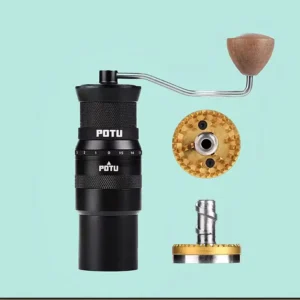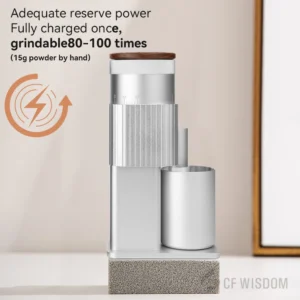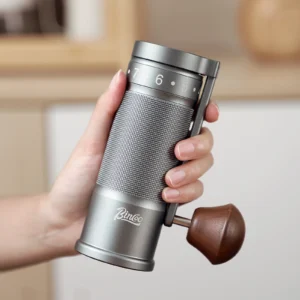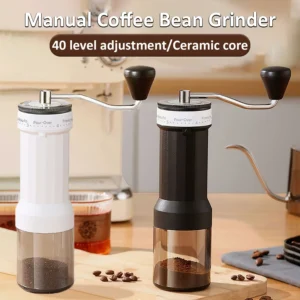Why Fresh Ground Coffee Transforms Your Camping Experience
There’s something magical about waking up in the wilderness, unzipping your tent, and being greeted by the smell of freshly ground coffee mingling with crisp morning air. Unlike pre-ground coffee that quickly loses its character, freshly ground beans release hundreds of aromatic compounds that create a sensory experience unlike any other.
When you grind coffee moments before brewing, you preserve the essential oils and flavor compounds that begin evaporating within minutes of grinding. These oils are what give coffee its rich body, complex flavor notes, and that heavenly aroma that can transform an ordinary camping morning into something extraordinary.
The ritual of hand-grinding coffee outdoors also adds a meaningful element to your camping experience. The methodical turning of a manual grinder connects you to the brewing process in a way that instant coffee never could. There’s a simple pleasure in slowing down and embracing this small luxury while surrounded by nature.
Understanding different travel-friendly coffee grinding options becomes essential when planning outdoor adventures where electricity is unavailable but quality coffee remains a priority. The right portable grinder bridges the gap between convenience and quality, allowing you to enjoy coffee as it was meant to be experienced – even miles from the nearest café.
Key Features to Consider When Choosing a Camp Coffee Grinder
Selecting the ideal coffee grinder for your outdoor adventures requires balancing several crucial factors. The camping environment presents unique challenges – limited space in your pack, no electricity, potential exposure to moisture and dust, and the need for equipment that can withstand being transported over rough terrain.
The perfect camp grinder needs to be portable without sacrificing performance. It should provide consistent grounds while being easy to operate and maintain in outdoor conditions. Modern portable coffee grinder options come in various designs, each with distinct advantages depending on your specific camping style.
Before diving into detailed comparisons, it’s important to understand that the ideal grinder for ultralight backpacking might differ significantly from what works best for car camping or RV trips. Your brewing method, group size, and personal priorities regarding weight versus grind quality will all influence your optimal choice.
Portability: Finding Your Ideal Weight and Size Balance
When it comes to camping coffee grinders, every ounce matters – especially if you’re carrying your equipment on your back. For backpackers, ultralight grinders weighing 8-12 ounces (230-340g) might be worth the investment, while car campers can afford the luxury of slightly heavier, more feature-rich options.
Size considerations extend beyond just weight. Look for:
– Compact dimensions that fit efficiently in your pack
– Cylindrical shapes that utilize space efficiently
– Foldable or removable handles that reduce packed size
– Protective features that don’t add excessive bulk
The materials used significantly impact both weight and durability. Aluminum options provide a good balance of lightweight construction and reasonable strength, while lightweight hand grinders camping enthusiasts often prefer titanium components for their superior strength-to-weight ratio. Plastic components can reduce weight but may sacrifice longevity.
Remember that the most portable option isn’t always the best overall choice – finding your personal balance between packability and functionality is key to coffee satisfaction in the wilderness.
Grind Consistency: The Foundation of Great Camp Coffee
The difference between a mediocre cup and an exceptional one often comes down to one crucial factor: grind consistency. Uniform coffee particles extract at the same rate, producing balanced flavor without the bitterness of over-extraction or the weakness of under-extraction.
In the camping context, hand burr grinder models significantly outperform blade grinders. While blade grinders simply chop beans randomly, burr grinders crush beans between two surfaces with precision. This creates particles of consistent size, which is especially important for methods like pour-over and AeroPress that are popular in camping settings.
Burr material choices typically include:
– Ceramic burrs: Lightweight and won’t rust, but can crack if dropped
– Stainless steel burrs: Extremely durable and often sharper, resulting in faster grinding
– Hardened steel alloys: Premium option offering exceptional longevity and precision
Adjustability mechanisms vary widely between portable models. The best camping grinders offer clearly defined settings rather than stepless adjustment, as these maintain their settings during transport and are easier to use consistently in field conditions.
For most camping brew methods, you’ll need medium-coarse settings (for pour-over) to coarse settings (for French press), though having the versatility to produce fine grounds for AeroPress can be valuable for coffee enthusiasts who prefer this method.
Durability: Built for Outdoor Adventures
Camping subjects your equipment to harsher conditions than home use ever would. From unexpected downpours to accidental drops on rocky surfaces, your coffee grinder needs to withstand the unpredictable nature of outdoor adventures.
The most durable all-metal hand grinder options feature:
– Full metal construction with minimal plastic components
– High-grade aluminum or stainless steel bodies
– Sealed bearings that resist dirt and moisture
– Burrs made from hardened steel or ceramic that maintain sharpness
– Reinforced attachment points where handles connect to the body
Look for grinders with silicone or rubber components that provide shock absorption and improved grip when hands are wet or cold. Some premium models offer water-resistant seals that protect internal mechanisms from morning dew or unexpected rain, an invaluable feature for extended outdoor use.
While warranties rarely cover “adventure damage,” several manufacturers design specifically for outdoor use and understand the conditions their products will face. These specialized outdoor grinders often feature thicker walls, reinforced components, and simplified designs with fewer breakable parts.
Manual vs. Electric: Choosing Your Power Source
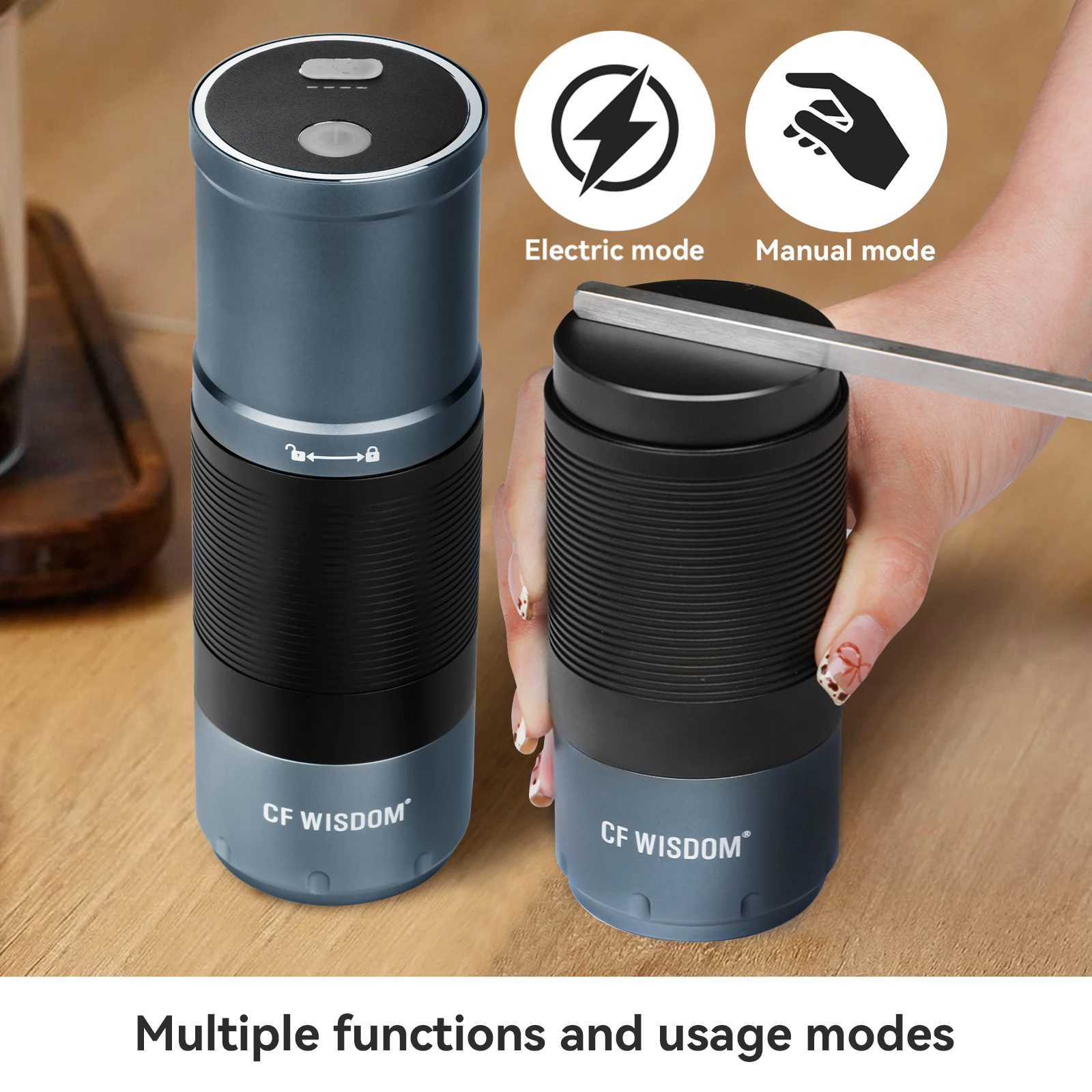
The choice between manual and electric grinders represents one of the most significant decisions for your camping coffee setup. Each option offers distinct advantages depending on your priorities and camping style.
Manual grinders excel in:
– Reliability with no batteries or power source needed
– Lighter weight (typically 8-16 oz/230-450g)
– Nearly silent operation that won’t disturb fellow campers or wildlife
– Therapeutic grinding ritual that connects you to the coffee preparation process
– Typically more compact designs ideal for limited pack space
Electric options offer benefits including:
– Significantly faster grinding (20-40 seconds vs. 2-3 minutes for manual)
– Less physical effort, especially valuable for larger groups
– More consistent results for less experienced users
– Convenience that may encourage more frequent fresh grinding
For most wilderness camping scenarios, manual coffee grinders travel companions prove more practical and reliable. However, for car camping, RV trips, or base camp setups where power sources are available, electric models can save significant time when preparing coffee for groups.
Battery life for portable electric grinders typically ranges from grinding 5-10 batches per charge, with USB-rechargeable options becoming increasingly common. Some can connect to power banks, making them suitable for extended trips with portable power solutions.
Capacity: Matching Your Grinder to Your Coffee Needs
When selecting a travel coffee grinder, capacity considerations can dramatically impact your camp coffee experience. Most portable grinders hold between 15-70g (0.5-2.5 oz) of beans, which translates to approximately 1-5 cups of coffee depending on your brewing strength preference.
For solo campers or pairs, smaller capacity grinders around 20-30g offer the best balance of size and functionality. Groups of 3-4 will benefit from medium capacity options (40-50g), while larger groups should consider either high-capacity models (60g+) or plan for multiple grinding sessions.
Consider these practical guidelines:
– Single cup brewing typically requires 15-18g of coffee
– A couple sharing coffee needs approximately 30-35g
– Family-size French press preparations might use 45-60g
The relationship between capacity and grinding time is direct – larger capacity means more beans to grind, extending the time and effort required. For manual grinders, this becomes especially relevant when preparing coffee for multiple people.
Some clever designs allow for coffee grounds storage directly in the grinder body or include integrated containers for beans, reducing the need for separate storage solutions and minimizing pack clutter.
Ease of Cleaning and Field Maintenance
Maintaining your grinder in the field presents unique challenges. Limited water supplies and basic cleaning tools mean you need a grinder designed with easy maintenance in mind.
The best camping grinders feature:
– Tool-free disassembly for quick cleaning
– Smooth surfaces that don’t trap coffee residue
– Minimal nooks and crannies where moisture can accumulate
– Materials that naturally repel oils and don’t absorb odors
Developing good essential manual grinder cleaning guide practices is crucial for field maintenance. After each use, disassemble only as needed and tap components firmly to remove loose grounds. Use a small brush (many grinders include one) to clear residual particles from burrs and threads.
For extended trips, pack a few cleaning-specific tools:
– Small bottle brush or pipe cleaners for narrow chambers
– Microfiber cloth for wiping components
– Soft bristle brush for burr cleaning
– Small container for collecting waste grounds
Between trips, perform a more thorough cleaning at home using warm water and mild soap on non-burr components, ensuring everything is completely dry before storage to prevent corrosion or mold growth.
Operating Noise: Respecting Nature and Fellow Campers
One often overlooked aspect of camp coffee preparation is noise level. In the quiet of early morning at a campsite, loud grinding can disturb both wildlife and fellow campers – an important consideration for those who value wilderness etiquette.
Manual grinders have a significant advantage in this category, with most quiet travel-friendly grinders producing only a gentle crushing sound rather than the high-pitched whir of electric motors. The difference is substantial – typically 40-50 decibels for manual grinders versus 70-85 decibels for portable electric options.
To further minimize noise when using any grinder:
– Place a towel or pad under the grinder to dampen vibrations
– Grind inside your tent or away from sleeping areas
– Hold the grinder firmly to reduce rattling
– Consider grinding the evening before for early morning brewing
In shared camping areas, be mindful of quiet hours – typically from 10pm to 7am in most campgrounds. If you’re an early riser eager for that first cup, manual grinding inside your tent or at a distance from others shows consideration while still allowing you to enjoy freshly ground coffee.
Top Portable Manual Grinders for the Outdoors
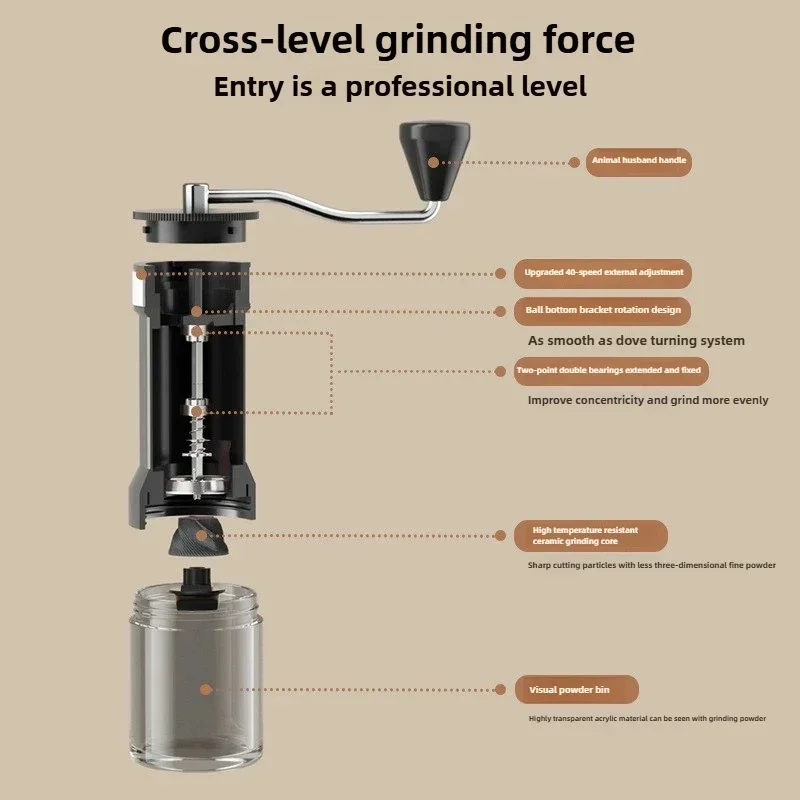
After extensive testing in various camping conditions, these manual grinders stand out for their exceptional combination of portability, performance, and durability in outdoor settings.
Precision Alpine Grinder
This premium handheld coffee grinder features all-metal construction with a stainless steel body weighing just 11.5 oz (326g). Its standout features include 38mm hardened steel burrs, a unique magnetic catch cup that prevents accidental separation during transport, and 15 clearly-defined grind settings. The foldable handle reduces packed size by 30%, making it ideal for backpackers who refuse to compromise on coffee quality. Capacity: 25g (enough for 2 cups).
Expedition Burr Mill
Designed specifically for rugged conditions, this grinder combines aluminum construction with ceramic burrs for an excellent weight-to-performance ratio at 9.8 oz (278g). The sealed bearing system prevents dust and moisture infiltration, while silicone grip sections improve handling in wet conditions. Its slightly larger capacity (35g) makes it suitable for couples or small groups. The simplified 5-setting adjustment system is very stable, maintaining settings even when packed roughly.
Trail Master Compact
The ultralight option at just 8.2 oz (232g), this grinder utilizes aerospace-grade aluminum with titanium-coated steel burrs. While its capacity is modest at 20g, its incredibly small packed dimensions (fitting in a standard mug) make it perfect for minimalist backpackers. The innovative stabilizing base allows it to rest securely on uneven surfaces – a thoughtful touch for camp environments.
Summit Premium Manual
The most robust option, this stainless steel powerhouse weighs 15.2 oz (431g) but offers unmatched durability and a generous 45g capacity. Its precision-cut burrs produce extremely consistent grounds, particularly at medium and coarse settings ideal for camping brew methods. The extra-long handle provides excellent leverage, reducing effort during grinding – a valuable feature when preparing coffee for groups.
Best Portable Electric Grinders for Camp Convenience
For situations where power is available or weight less critical, these electric models deliver impressive performance in outdoor settings:
Nomad USB Grinder
This compact electric model weighs 12 oz (340g) and features ceramic conical burrs powered by a rechargeable battery. One charge grinds enough for approximately 8-10 cups, while the USB-C charging capability allows power banks to extend its use indefinitely. The noise level is remarkably low for an electric model, though still noticeably louder than manual alternatives. Best suited for car camping or base camps with power sources.
Adventure Power Burr
This robust option combines durability with electric convenience, featuring a reinforced polymer body with metal internal components. At 16 oz (453g), it’s heavier than most manual grinders but offers significantly faster grinding (25-30 seconds for a full 30g capacity). The removable battery can be swapped in the field, though finding AA batteries may be challenging in remote locations. Its rubber-sealed components provide good protection against morning dew and light rain.
Budget-Friendly Options That Don’t Sacrifice Quality
Quality coffee equipment often comes with premium pricing, but these affordable options deliver surprising performance without breaking the bank:
Trail Companion Basic
This aluminum and plastic hybrid design weighs 10.5 oz (298g) and features ceramic burrs that perform admirably, particularly for medium and coarse grinds. While adjustment precision isn’t quite as refined as premium models, it delivers remarkably consistent results at less than half the price of high-end options. Its 25g capacity suits most individual or paired camper needs, and the simplified design means fewer components that could potentially fail.
Explorer Economy Grinder
This entry-level all-metal design prioritizes durability and simplicity at a budget-friendly price point. At 11.8 oz (334g), it’s slightly heavier than some premium models but offers comparable grind consistency for French press and pour-over preparations. The adjustable grind setting uses a simpler click system with fewer steps but remains stable during transport. Its standard 20g capacity works well for individual campers.
Fine Adjustment Hand Grinder, Precision Manual Grinder, Travel Coffee Grinder
Price range: $185.11 through $494.63 Select options This product has multiple variants. The options may be chosen on the product pageHand Burr Grinder, Hand Crank Coffee Grinder, Manual Espresso Grinder, Portable Coffee Grinder
Price range: $262.72 through $300.22 Select options This product has multiple variants. The options may be chosen on the product pageHand Burr Grinder, Manual Coffee Grinder Stainless Steel, Precision Manual Grinder
Price range: $183.64 through $187.52 Select options This product has multiple variants. The options may be chosen on the product pageCeramic Burr Coffee Grinder, Hand Burr Grinder, Hand Crank Coffee Grinder, Manual Coffee Bean Grinder
Price range: $59.17 through $59.96 Select options This product has multiple variants. The options may be chosen on the product page
Comparative Guide: Finding Your Perfect Match

Selecting your ideal camping grinder becomes clearer when examining how different models align with specific outdoor activities. Many outdoor enthusiasts find that compact coffee grinders backpackers prefer differ substantially from those ideal for car camping or base camp scenarios.
| Grinder Model | Weight | Capacity | Burr Type | Best For | Price Range |
|---|---|---|---|---|---|
| Precision Alpine | 11.5 oz (326g) | 25g | Steel | All-around performance | $$$ |
| Expedition Burr Mill | 9.8 oz (278g) | 35g | Ceramic | Couples/groups | $$ |
| Trail Master Compact | 8.2 oz (232g) | 20g | Steel | Ultralight backpacking | $$ |
| Summit Premium | 15.2 oz (431g) | 45g | Steel | Durability/groups | $$$ |
| Nomad USB (Electric) | 12 oz (340g) | 30g | Ceramic | Car camping | $$ |
| Trail Companion Basic | 10.5 oz (298g) | 25g | Ceramic | Budget backpacking | $ |
For ultralight backpacking where every ounce matters, the Trail Master Compact offers the best weight-to-performance ratio. Weekend car campers might prefer the convenience of the Nomad USB electric model. Extended wilderness trips benefit from the durability of the Summit Premium, while budget-conscious campers can rely on the Trail Companion Basic without significant quality compromise.
Mastering the Perfect Grind: Technique and Settings
Achieving optimal results from your portable grinder requires both proper technique and appropriate grind settings for your brewing method. The environment of camping adds unique challenges to this process.
For efficient hand grinding:
1. Find a stable position – brace the grinder between your knees or against a flat surface
2. Use smooth, continuous motions rather than rapid jerky turns
3. Maintain consistent pressure throughout the grinding process
4. Allow the weight of the beans to feed naturally into the burrs
Understanding AeroPress grind settings travel considerations is particularly valuable, as this brewing method is popular among campers for its versatility and compact size. For AeroPress, aim for a medium-fine consistency similar to table salt. Pour-over methods typically require a medium grind resembling coarse sand, while French press works best with a coarse grind similar to sea salt.
When judging grind size visually, compare to familiar references:
– Fine: Similar to granulated sugar
– Medium: Like coarse sand
– Medium-coarse: Resembles raw sugar
– Coarse: Similar to sea salt flakes
Start with the recommended setting for your brewing method, then adjust based on taste. Too bitter or slow extraction indicates your grind is too fine; weak or watery coffee suggests it’s too coarse.
Field Maintenance: Keeping Your Grinder at Peak Performance
Maintaining your grinder in the field extends its lifespan and ensures consistent performance throughout your trip. Develop these simple habits:
After each use:
– Tap the grinder firmly to dislodge loose grounds
– Brush visible grounds from burrs and collection chamber
– Store in a dry place, preferably inside your tent at night
For trips lasting several days:
– Perform a more thorough clean every 2-3 days
– Use a small brush to reach between burr teeth
– Wipe down external surfaces, particularly where oils accumulate
– Check adjustment mechanisms for coffee buildup
– Ensure moving parts remain smooth and free from obstruction
In humid environments, disassemble the grinder more frequently to prevent moisture buildup in hidden areas. In dusty conditions, pay special attention to keeping seals and moving parts clean.
Store your grinder in a protective bag or case between uses, preferably with a small silica gel packet during humid trips. This prevents not only physical damage but also moisture-related issues that can affect burr performance.
Frequently Asked Questions About Camp Coffee Grinders
How long does it take to hand-grind enough coffee for two people?
Typically 1-2 minutes depending on the grinder efficiency, bean hardness, and grind setting. Coarser grinds for French press are faster, while finer settings require more time and effort.
Can I use my home electric grinder while camping?
Standard home grinders require 120V AC power, making them impractical for most camping situations. Purpose-built portable electric grinders with rechargeable batteries are a better option when electricity isn’t available.
How do I protect my grinder from damage during transport?
Many premium grinders come with protective cases. If yours doesn’t, wrap it in a soft cloth and store in a container that prevents impacts. For backpackers, placing the grinder inside a sock and storing in the center of your pack works well.
Which grind setting is most versatile for various camping brew methods?
A medium-coarse setting works reasonably well for most camping methods including pour-over, French press, and AeroPress (using longer steep times). If you must choose just one setting, this provides the most flexibility.
How do I clean my grinder with limited water?
Use a brush to remove grounds, then wipe components with a dry cloth. A small amount of rice ground through the system can help absorb oils without using water. Complete cleaning with water can wait until you return home.
Are ceramic or steel burrs better for camping?
Steel burrs are generally more durable for rough camping conditions, while ceramic burrs are lighter and won’t rust. For backpacking, ceramic offers weight advantages; for rugged conditions, steel provides better durability.
Completing Your Camp Coffee Kit: Beyond the Grinder
Your freshly ground coffee deserves brewing equipment that maintains this quality standard. Consider these complementary items to create a complete camp coffee experience:
For brewing, the AeroPress has become a favorite among outdoor enthusiasts for its lightweight design, durability, and exceptional results. Collapsible silicone pour-over cones also offer excellent brewing with minimal pack space, while lightweight French press options work well for groups.
Bean storage demands special attention in outdoor conditions. Look for containers with one-way valves that release CO2 while preventing oxygen exposure. Small airtight containers with silicone seals protect beans from both moisture and crushing during transport.
Water heating options range from ultralight titanium pots used with pocket stoves to more substantial kettles with gooseneck spouts for pour-over precision. The ideal choice depends on your weight restrictions and brewing method.
The complete minimalist kit (grinder, brewer, storage, heating) can weigh as little as 1.5 pounds (680g), while a more luxurious setup with multiple brewing options might approach 3-4 pounds (1.4-1.8kg) – still reasonable for the significant improvement in coffee quality over instant alternatives.
By investing in quality equipment designed specifically for outdoor use, you transform ordinary camping mornings into extraordinary coffee experiences that rival your favorite café – all while enjoying the incomparable ambiance of nature.


